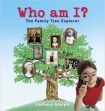Who Am I?: The Family Tree Explorer by Anthony Adolph
| Who Am I?: The Family Tree Explorer by Anthony Adolph | |
|
| |
| Category: Children's Non-Fiction | |
| Reviewer: Magda Healey | |
| Summary: Great primer for family history research, recommended for all (interested) children from about 8 onwards. It puts genealogy in a wider context and offers a wealth of background knowledge, interesting trivia and practical advice including activity suggestions. | |
| Buy? Yes | Borrow? Yes |
| Pages: 208 | Date: May 2009 |
| Publisher: Quercus Publishing | |
| ISBN: 978-1847245090 | |
|
| |
A fascination with family history seems more than just a passing fad: for many it's a hobby approaching an obsession and in a mobile (both geographically and socially) and globalised society, people unable to answer a 'where we are all going' question find security and identity in pursuing an answer to 'where do I come from?'
Who Am I? is an introduction to family history research for children. Adolph is a professional genealogist who co-presented Channel 4's Extraordinary Ancestors and BBC's Gene Detectives and Who Am I? combines information and practical tips on researching family history with curious facts, interesting trivia and illuminating background information on how family trees are made and used in various cultures, 'life in the past' social history, heraldry, meaning and history of names and even evolutionary tree of life and genetics.
This considerably widens Who Am I?' s appeal: although it's mostly a family history primer, it puts the strictly genealogical research in a wider context and thus makes it more meaningful and worthwhile.
It's only the pen-ultimate chapter that goes beyond oral history and introduces staple genealogy sources like parish records and census returns.
Who Am I? consists of fourteen chapters, each exploring different aspect of family history research: oral history, drawing a family tree, unravelling various connections and understanding terms for distant relatives, old photos, exploring geographical movements and immigration, historical timeliness, evolution, celebrations, family trees in fiction and myth, surnames and others.
The anecdotes and trivia included in Who Am I? are well selected. Did you know that Vlad the Impaler (aka Dracula) was Prince William's ancestral uncle, while Genghis Khan was William's direct ancestor? Family trees in Harry Potter and Hobbit are covered as is inheritance of genes for rolling your tongue and bending the thumb backwards.
General information, anecdote and numerous examples (many taken from Adolph's own family history) are combined with activities which are both age-appropriate and relevant. There are forms to record oral history and suggestions for making various styles of family tree, personalising the historical timeline, playing Chinese whispers with surnames, creating a family heirloom box and even growing a real 'family tree'.
Adolph's own passion for genealogy comes across very strongly and Who Am I? is an excellent introduction to family history research for young readers.
It's clearly written, handsomely produced and illustrated with images which add information as well as adorn. It should be accessible to any confident readers, although it's probably aimed at the older primary school children and younger teenagers (9 to 12 age group). There is nothing particularly dumbed down or oversimplified in Who Am I? and I can easily imagine a parent-and-child team using it as a basic introduction to family history research.
Similarly to a lot of family history materials, Who Am I? has a somehow middle-class-plus focus, but that is probably unavoidable in all but the most specialised publications.
It could definitely do with more source suggestions. The majority of suggested general reading are books by Adolph himself, but particularly the list of suggested websites is woefully inadequate, mentioning only genuki and genesreuinted (and everygenreation.co.uk for black children). One site that certainly warrants mention is ancestry.com, where a huge amount of source data (birth and death records, census returns, passenger lists from immigrant ships) is available, but there are many others that a list of sources could (and should) include.
I have always been somehow suspicious of the notion that one's ancestry explains one's identity and answers the 'who am I?' question. It feels inherently reactionary and parochial: the chance to transcend accidents of birth is one of the achievements of modernity. But many people feel the need to find their connection to past generations; for children, family history can provide a link to history at large by making it more intimate and more vivid. Who Am I? is a good place to start.
The review copy was sent to the Bookbag by the publisher - thank you!
Children who enjoy this type of book will probably also enjoy Crimebusters by Clive Gifford.
Please share on: ![]() Facebook,
Facebook, ![]() Twitter and
Twitter and
![]() Instagram
Instagram
![]() You can read more book reviews or buy Who Am I?: The Family Tree Explorer by Anthony Adolph at Amazon.co.uk Amazon currently charges £2.99 for standard delivery for orders under £20, over which delivery is free.
You can read more book reviews or buy Who Am I?: The Family Tree Explorer by Anthony Adolph at Amazon.co.uk Amazon currently charges £2.99 for standard delivery for orders under £20, over which delivery is free.
![]() You can read more book reviews or buy Who Am I?: The Family Tree Explorer by Anthony Adolph at Amazon.com.
You can read more book reviews or buy Who Am I?: The Family Tree Explorer by Anthony Adolph at Amazon.com.
Comments
Like to comment on this review?
Just send us an email and we'll put the best up on the site.
Anthony Adolph said:
My book introduces the subject of family history to children and shows them how much they can do and find out at home. It also introduces the sorts of records that children will find in the loft, or be shown by relatives, and explains them in a simple way. The book is now not intended to be a practical guide to researching family trees in archives or using pay-to-view websites such as Ancestry.com. I thought long and hard about this, and realised that such original research does not magically become simpler or cheaper if it is undertaken by a child. A guide simplified for children would simply miss out much that anyone, of whatever age, would need to know. That is why, at the end of the book, I tell my young readers that, if they are keen to progress to archival or internet research, they can read my 'adult' books on the subject.


